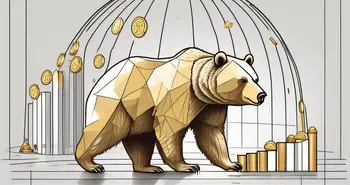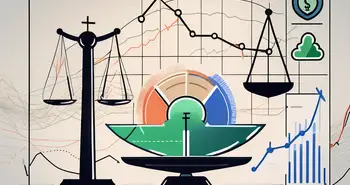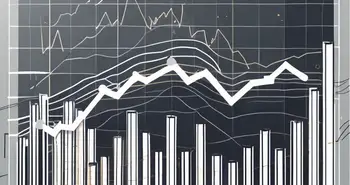Systemic Risk vs Market Risk: Understanding the Key Differences

As an expert in the field of finance, I want to shed light on an important topic that often causes confusion among investors and financial professionals alike: systemic risk and market risk. In this article, we'll define these key concepts, explore their causes and impacts, and highlight the differences between them. So let's dive right in!
Defining Key Concepts: Systemic Risk and Market Risk
What is Systemic Risk?
Systemic risk refers to the potential for a widespread disruption or collapse of an entire financial system, triggered by the failure of a specific institution or a series of interconnected events. This type of risk is often associated with the interconnectedness of financial institutions and markets, where the failure of one entity can have far-reaching consequences across the entire system.
Imagine a scenario where a major bank fails, leading to a domino effect that brings down other financial institutions, causing panic in the market and a severe economic downturn. This is the essence of systemic risk. To mitigate systemic risk, regulators often impose measures such as capital requirements, stress tests, and oversight to ensure the stability of the financial system.
In recent history, the 2008 financial crisis serves as a stark reminder of the dangers of systemic risk. The collapse of major financial institutions and the subsequent ripple effects through global markets highlighted the interconnected nature of the financial system and the devastating impact of systemic risk when left unchecked.
What is Market Risk?
Market risk, on the other hand, revolves around the potential for investment losses due to the fluctuation or decline in overall market conditions. It is the possibility of losing money because of factors such as economic downturns, political events, or even changes in investor sentiment. Market risk is inherent in all types of investments and is influenced by a wide range of external factors beyond an investor's control.
For example, if you're invested in the stock market and the general market experiences a downturn, the value of your investments may decrease, leading to losses. Market risk can be categorized into various types, including equity risk, interest rate risk, currency risk, and commodity risk, each presenting unique challenges and opportunities for investors.
To manage market risk, investors often diversify their portfolios across different asset classes, regions, and industries to reduce the impact of adverse market movements on their overall investment performance. Additionally, risk management tools such as hedging strategies, stop-loss orders, and options contracts can be employed to mitigate the potential losses associated with market fluctuations.
Diving Deeper into Systemic Risk
Causes of Systemic Risk
Systemic risk can arise from various sources, such as excessive leverage, interconnectedness among financial entities, inadequate risk management practices, or even events like natural disasters. These factors have the potential to disrupt the functioning of the entire financial system and have a cascading effect on the economy.
For instance, during the 2008 financial crisis, the collapse of Lehman Brothers, a prominent investment bank, triggered a chain reaction that threatened the stability of the global financial system.
Impact of Systemic Risk on the Economy
The consequences of systemic risk can be far-reaching and devastating. When a financial system faces a systemic crisis, it can lead to a sharp decline in economic activity, widespread job losses, and a collapse in investor confidence. Governments often intervene to stabilize the system and prevent further damage.
Personally, I vividly remember the turmoil during the 2008 financial crisis. Companies went bankrupt, housing markets crashed, and many individuals lost their hard-earned savings. It was a grim reminder of the power of systemic risk.
Exploring the Nature of Market Risk
Factors Contributing to Market Risk
Market risk stems from a variety of factors, such as economic indicators, geopolitical events, interest rate changes, or even industry-specific risks. It affects all participants in the market, from individual investors to large institutions.
As an expert in the field, I've seen how market risk can be influenced by unexpected events. For example, political tensions or natural disasters can quickly send shockwaves through financial markets, causing volatility and impacting investment portfolios.
How Market Risk Affects Investments
When market conditions turn unfavorable, asset prices tend to fall and market participants face the risk of losing money. This risk is inherent in any investment, regardless of the asset class, be it stocks, bonds, real estate, or commodities.
A lesson I've learned over the years is the importance of diversification. By spreading your investments across different asset classes and sectors, you can mitigate the impact of market risk on your portfolio.
Contrasting Systemic Risk and Market Risk
Similarities Between Systemic and Market Risk
Both systemic risk and market risk are forms of financial risk that investors and market participants must contend with. Furthermore, they can both result in significant losses and pose challenges to the stability of the financial system.
Distinct Differences Between Systemic and Market Risk
The key difference between systemic risk and market risk lies in their scope and origin. Systemic risk encompasses risks that can trigger a broad-based collapse of the entire financial system, whereas market risk pertains to the potential for losses arising from market conditions.
While market risk can be managed through diversification and risk management techniques, systemic risk requires a more comprehensive approach, often involving government intervention and regulatory measures.
Mitigating Systemic and Market Risks
Strategies for Managing Systemic Risk
Given the far-reaching implications of systemic risk, it is crucial to have robust risk management practices in place. This includes effective regulatory oversight, stress testing of financial institutions, ensuring adequate capital cushions, and promoting transparency in the financial system.
Having witnessed firsthand the impact of systemic risk, I encourage investors and financial institutions to stay vigilant and continuously assess their exposure to systemic threats.
Techniques for Reducing Market Risk
Market risk can be mitigated through various strategies. Diversification, as mentioned earlier, is key. By spreading your investments across different asset classes and regions, you can reduce the impact of market downturns on your portfolio.
Additionally, keeping a long-term perspective, staying informed about market trends, and aligning your risk appetite with your investment goals are crucial for managing market risk effectively.
Now let's address some frequently asked questions:
FAQ
What is the main difference between systemic risk and market risk?
The main difference is that systemic risk is the potential for a widespread disruption or collapse of the entire financial system, while market risk refers to the potential for investment losses due to fluctuations in overall market conditions.
How can investors protect themselves from market risk?
Investors can protect themselves from market risk by diversifying their portfolios, staying informed about market trends, and aligning their risk tolerance with their investment goals.
What are some examples of systemic risk?
Examples of systemic risk include the collapse of major financial institutions, contagion effects due to interconnectedness, or unexpected events that have a severe impact on the entire financial system, such as natural disasters.
What lessons can we learn from past systemic and market risks?
From past experiences, we've learned the importance of effective risk management practices, regulatory oversight, and the need for diversification to mitigate the impacts of systemic and market risks. Staying informed and continuously assessing risks are key components of a resilient financial system.
In conclusion, understanding the differences between systemic risk and market risk is vital for investors, financial professionals, and regulators. By recognizing the distinct nature of these risks and implementing appropriate risk management strategies, we can navigate the complex world of finance with greater confidence and resilience.
As you navigate the complexities of systemic and market risks, it's essential to have a trading platform that aligns with your need for diversification and innovative risk management tools. Morpher is designed to empower you with zero fees, infinite liquidity, and the ability to trade a vast array of assets, from stocks to the most cutting-edge markets like NFTs. With features like fractional investing, short selling without interest fees, and up to 10x leverage, Morpher offers a unique trading experience on the Ethereum Blockchain. Take control of your investments with the safety and flexibility of the Morpher Wallet. Ready to transform your trading experience? Sign Up and Get Your Free Sign Up Bonus today and join the future of investing with Morpher.

Disclaimer: All investments involve risk, and the past performance of a security, industry, sector, market, financial product, trading strategy, or individual’s trading does not guarantee future results or returns. Investors are fully responsible for any investment decisions they make. Such decisions should be based solely on an evaluation of their financial circumstances, investment objectives, risk tolerance, and liquidity needs. This post does not constitute investment advice.

Painless trading for everyone
Hundreds of markets all in one place - Apple, Bitcoin, Gold, Watches, NFTs, Sneakers and so much more.

Painless trading for everyone
Hundreds of markets all in one place - Apple, Bitcoin, Gold, Watches, NFTs, Sneakers and so much more.









